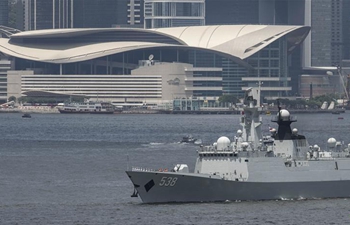
Visitors board Olympias, a replica of an ancient Greek trireme, to sail in the waters of the Saronic Gulf off Athens' southern coast, on July 12, 2017. Following the successful trips of the trireme in the summer of 2016, the Hellenic Navy has organized a new series of seven sails during July and September, offering people aged between 15 and 75 an opportunity to take part in this unique sail trip to the past. (Xinhua/Lefteris Partsalis)
by Alexia Vlachou
ATHENS, July 13 (Xinhua) -- Sailing with an ancient Athenian wooden trireme was a dream to come true for most of the visitors who boarded on the "Olympias" trireme on Wednesday afternoon at the Hellenic Maritime Heritage Park in the coastal area of Paleo Faliro, a southern suburb of Athens.
Following the successful trips of the trireme in the summer of 2016, the Hellenic Navy has organized a new series of seven sails during July and September, offering people aged between 15 and 75 an opportunity to take part in this unique sail trip to the past.
"Olympias trireme is a replica of an Athenian trireme which was constructed from 1985 to 1987. Launched in 1987 at Keratsini shipyards, the trireme is commissioned by the Hellenic Navy," the captain of the trireme, commander Nikolaos Polychronakis told Xinhua.
The 37-meter full scale working replica of a 2,000-year-old trireme warship, named "Olympias", was used as part of an experimental archeological project to determine its sailing characteristics, the strength, the battle tactics and the living conditions inside the vessel.
After a period of repairs, the trireme took its place back to sea at the Museum of Naval Tradition. Aiming at safeguarding and promoting the country's naval tradition, the Hellenic Navy introduced the sails with crews of citizens who volunteer to row to come closer to history.
As the history of Greece is strongly connected with the sea, tourists and locals have responded to the invitation of the Hellenic Navy with great eagerness.
"People's response is great, especially children who learn about the ancient Greek history at schools. They see a true legend in front of them. They observe the ornaments, like the eye decorated at the bronze ram on the front of the ship and they feel love for the ship," Polychronakis added.
"I teach ancient Greek history to schools. So, I have told many times stories on how the ancient triremes were sailing, but it is the first time I will get on board on one," Eleni Georgakopoulou told Xinhua.
"In Greece, we use to say metaphorically that "we row every day" meaning that we have harsh times in our daily life. But, now we all will row literally to enjoy this exquisite experience," she stressed.
Despite the high temperatures and the heatwave, people of all ages were waiting in line to get on board. Feeling excited to be a rower, Ioannis Pantis would not miss this for a thing. "We want to live the history from first hand, we will row with all our strength and in coordination with the others. We want to travel back to history and to live the experience with the trireme," he said.
As soon as the visitors were on their seats, captain Polychronakis explained to the crew how they will row under his commands to be coordinated and to make the ship sail. After two hours of sailing, visitors returned tired, but still thrilled from the voyage and the experience to row an ancient trireme.
What was its advantage in comparison to other ships? "The trireme was a flexible battleship and its main weapon was its ram," Polychronakis highlighted.
In antiquity, and especially throughout the fifth century, the triremes served as chariots of the sea, and were designed to be fast, aggressive attack ships with light displacement.
With its shallow draught, the trireme could develop high speed and be very flexible in attacks.
In the question on the living conditions inside the vessel, Polychronakis explained that it was not even possible to walk on the ship, but there were techniques for the crew to rest.
"The trireme was an ancient warship that was used only in battles, so the conditions inside were not easy. The space of each rower was limited to its seat, they could carry only fresh drinking water and dry food to stay hydrated. Each member of the crew had a specific role to serve, so as the space of the trireme was so limited that they could not store anything not even walk," he said.















